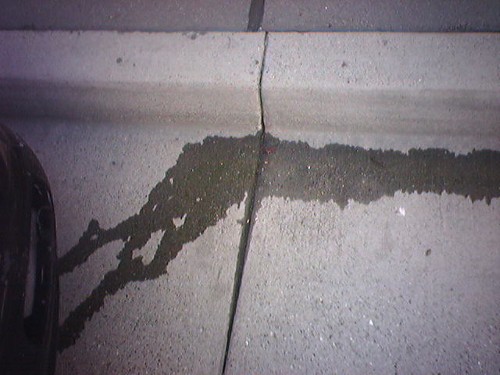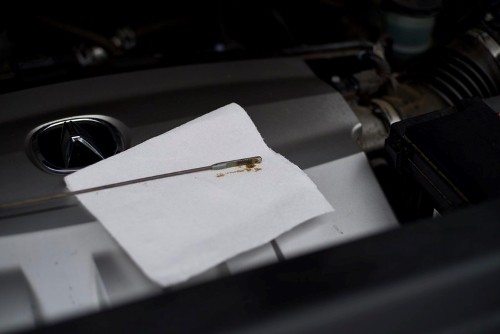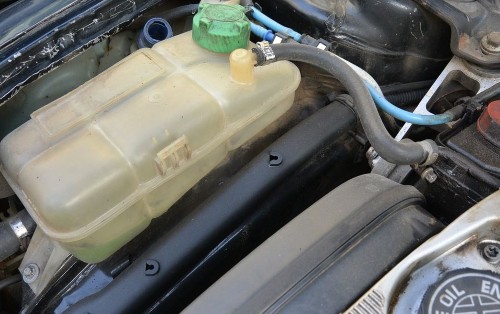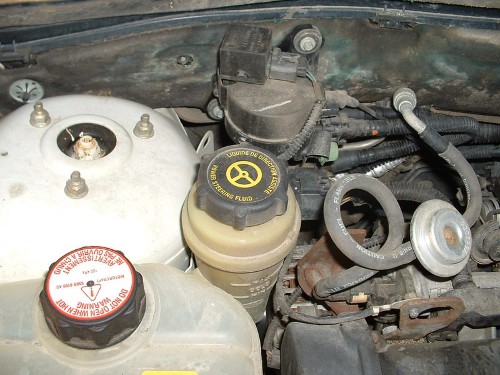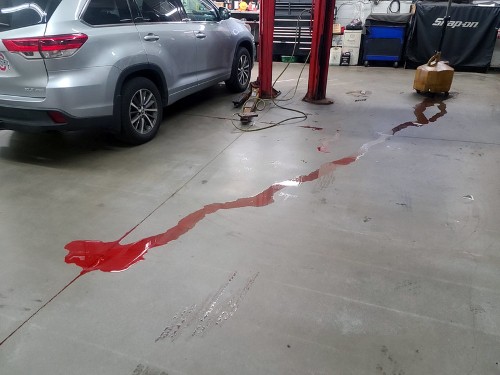Pulling out of your parking spot to see a puddle of fluid on the ground can be unsettling. What is that pink fluid leaking from your car? Is that puddle on the ground even from you? Regardless of what type of car you are driving and what engine it uses, leaks can happen. It may not always be easy to tell if it actually came from your car, but there are a few techniques you can use to help determine that. If it is from your car, now comes the guessing game of what it could possibly be. Vehicles have several different kinds of fluids running through them for a variety of reasons, none of which should be leaking onto the ground. We will first discuss a few different ways to check if it is from your car and then the fluids themselves that are being used.
10 by alex roberts / CC BY 2.0
This is enough liquid to draw your attention to a potential problem. You can run your fingers over the fluid to see if it is still fresh and if you just parked there it could be a sign it is from your car.
Before getting into any of this let’s save ourselves some time and effort and rule out the obvious ‘leaking’ from your car. If it is a hot day and you are running your air condition, it is most likely just water condensation dripping from your car. Hot air is drawn to the cooling mechanisms used in the air conditioning system. Moisture in the air then condenses on those parts, specifically the evaporator core. Similar to having a cold drink outside on a humid day, you will see that your glass starts to ‘sweat’ This is just normal condensation building up.The same thing will happen to the cold cooling system parts, so before getting too worried about your car leaking, turn off the AC for a bit and see if the dripping stops.
A cold drink by OiMax / CC BY 2.0
A car will not exactly ‘leak’ water but rather drip it from cooling mechanisms. The more humid it is outside the more moisture will build up and drip onto the ground.
Determining if It’s Your Car Leaking
Maybe you share a driveway with your family or roommates. Maybe you leave your car in a general parking lot in your complex. If you don’t have a specific parking spot you can call your own it will be difficult to know for certain if the pool of fluid is actually from your car or the person who parked there before you. If you just came out to your car after leaving it for an hour or more, and you notice a puddle under your car you will probably want to know right away if that is actually from you. The quickest way to check can be to pop the hood open and see if there is anything that appears wet. Make sure the engine is cool before reaching your hands in. If you notice any hose or pieces that are damp run your fingers on it to check. Most fluids running in your car will have a smell or viscosity other than water. If you pull hands out and they are slippery and covered in a colored fluid, that most likely is your car fluid on the ground. However, this method is not a guaranteed way to diagnose a potential leak. Fluids could be leaking from other sections of your or just didn’t have enough force to splatter inside your engine compartment.
Old Man leans into motor compartment to repair parts. by Nenad Stojkovic / CC BY 2.0 When the engine compartment has cooled down, check the hoses to see if there is any liquid on them. You can also check the fluid reservoirs for cracks or signs of liquid.
To help determine if it truly is you, you will have to test it by parking in a fresh spot or place a white material on the ground under your car. It is important to go for a decent drive before posting up and waiting to see if a puddle appears. The leaking fluid may only be a problem when the car is warm or when certain systems have been used. To check if there is a drastic issue, the first step can be to park your car on a fresh surface with no previous staining and leave it idling for about five minutes. Once again you will want to make sure the car is warm before doing this. While the car is idling look at the undercarriage to check if you can see anything dripping. If there is noticeable dripping then yea, it is definitely your car making a mess in the parking lot. If it is that noticeable and happening that quickly there is a severe issue and the car should most likely not be driven any more. Fluids such as engine oil are 100% necessary so if you are heavily leaking fluid and not positive what it is, consider calling a tow truck or having a mechanic come to investigate.
However, most leaks are a lot more subtle and won’t just be pouring out of your car so you will have to check over a longer period of time. If you are going to take the time to really check, you should also set yourself up to know what the fluid is leaking. Parking in an untainted spot will help show if your car is leaking but to take it a step further and establish what the fluid is, a great method is to put white paper under your car. Fluid dripping onto black pavement or a colored concrete will make it tough to see what the color of the leaking liquid is. But using white paper as a canvas for the fluid to drip on will let you see the color better. Wrapping paper,specifically, is great to use. You can unravel a large strip to cover more ground and the material is not as absorbent as normal paper. If you don’t have wrapping paper, paper towels can also be good to use as well. Although it will absorb the fluid, the color will still be visible.
Checking up… by Tom Mills / CC BY 2.0 When checking for the quality and level of your oil it is common to run the dipstick over a clean paper towel to see what the color is. Using a paper towel under your car to determine the color of a leaking fluid will have the same success.
So you have an inclination that your car is leaking. Grab some spare wrapping paper and set up a large rectangular area in a parking spot with the white side facing up. Take your car for a moderate drive, 20-30 minutes should be sufficient, then go and park on top of the wrapping paper. Leave your car idling for about another 5 minutes or so then turn your car off. As mentioned before, you can check right away for any significant leaks, but if you don’t see anything right away leave it. You can check periodically, but leaving it overnight will give you more accurate results. Now that you just had a restless night guessing at how much it will cost to fix this leaking fluid, you can go and check. Keeping your fingers crossed, pull the paper out from under the car and see if there is anything there. If you were just overly paranoid and the paper is dry you can call it there, but if you pull it out and it is wet then let’s figure out what that fluid is.
Car Fluids
Pink fluid Leaking from car? You may be surprised to learn just how many fluids your car requires to function properly. If any of these fluids are leaking, old, or overused they can cause major issues including engine failure, overheating, braking problems and more. Like some parts on your car, these fluids need to be replaced at a specific cadence, but if they are leaking they will require immediate attention. Let’s discuss what these fluids do and some determining factors of their appearance, smell, and texture.
- Engine oil
- Coolant (Antifreeze)
- Power steering fluid
- Brake fluid
- Transmission fluid
- Windshield washer fluid
- Differential Fluid
Engine Oil
Step 5 by Robert Couse-Baker / CC BY 2.0
Clean engine oil can look drastically different from old, used oil. Fresh oil will look amber or honey colored.
Engine oil may be one of the fluids you are more familiar with and may have even changed yourself. It is essential for lubricating your engine and needs to be regularly maintained for engine health and the overall longevity of your car. Engine oil comes standard in two different options: conventional oil and synthetic. Most cars will use synthetic oil because it can last longer than its counterpart, but some older vehicles may require conventional oil. Regardless of what oil is being used they will look the same. But with that being said, new oil will look significantly different from used oil.
Used engine oil will lose it’s amber color and become a darker brown the longer it has been used. Oil that has been overused can even become black, but hopefully you are getting it changed often enough where you won’t see that color.
Engine oil will be a bit viscous so run your fingers through the fluid on the paper and see if it feels slippery or thick. Try to keep in mind where the leak is dripping from to help determine what it could be. Engine oil will most often leak from the oil pan located under your car towards the center. Checking the engine oil dipstick day over day to see if it is lessening can be a great way to check if that is the fluid leaking.
Why would your engine oil be leaking? Worn out seals or drain plugs could be the cause. This could be a relatively easy fix but if you use the wrong pieces or tools it can lead to even more leaking and in turn more problems. Oil pressure and the amount of engine oil being used is extremely important for your car to function properly so make sure to replace any oil that may have leaked out after fixing the root problem. Extremely low levels of engine oil can not only make your car run sluggish but can even prevent your car from starting.
Coolant (Antifreeze)
One of the more subtle fluids being used in your car, coolant can be easy to forget about until it’s too late. Coolant is the fluid being used to run through the systems of your car and keep them from overheating. It is pushed through a series of tubes, into your radiator, and eventually back into the reservoir where it will be recirculated. Even in the midst of a bitterly cold winter your car can still run the risk of overheating so keeping your coolant at its recommended level is essential for every month of the year. If you thought your car may have been leaking and then you notice your temperature gauge higher than normal, stop driving immediately. Well, regardless if you noticed a potential leak or not, if your car is overheating you will want to stop anyways, but if you did have a puddle under your car at least it gives you a better idea why it could be overheating. Some new cars, including the Volkswagen Golf R, will send an alert to your infotainment system warning you of low coolant levels. Coolant can naturally evaporate over time but if you do get this alert it is probably a good idea to check for leaks.
Coolant resides in a plastic reservoir located in the engine compartment. Before removing the cap from the reservoir make sure the car is completely turned off and cold to avoid hot gases or fluids from splashing out. In this example, the car is low on coolant and would need more added. There will usually be embossed lines on the reservoir indicating a minimum and maximum level.
Because of the long path coolant travels it can leak from a number of places. Damage to any of the hoses can cause leaking or even a crack in the reservoir itself. With the car cold, run your fingers over the hoses leading from the reservoir and the reservoir itself. If you feel any kind of wetness it is a good sign there is a leak. A loose or damaged radiator cap could also be the cause of leaking coolant so make sure to check that as well. If still uncertain, park over the white paper. Coolant can come in a variety of colors for different makes and models but generally will be a noticeably bright color.
Coolant colors
- Green – IAT (Inorganic Additive Technology)
- Orange – OAT (Organic Acid Technology)
- Yellow – HOAT (Hybrid OAT)
- Turquoise – HOAT (Hybrid OAT, Phosphate-free)
- Pink/Blue – P-HOAT (Phosphated HOAT)
- Purple – Si-OAT (Silicated HOAT)
If you aren’t sure what type of coolant your car requires you can refer to the owner’s manual. If you are just trying to find out what color your car uses to match the color of the puddle under your car, check the reservoir in your engine compartment. Most reservoirs are translucent so you can see the color being used.
Power Steering Fluid
Another liquid from your car you don’t want leaking on the ground, power steering fluid plays a crucial role in your ability to turn your steering wheel with ease. It is a hydraulic fluid used to transfer power in vehicles with power steering, which at this point should be in every car on the road. When turning the steering wheel, power steering fluid is using hydraulic pressure to move the piston in the steering gear. As the pressure begins to grow the piston moves which turns the vehicle in the direction you are rotating the wheel. However, even if your car leaked all of its power steering fluid you would still be able to rotate your wheel and turn your car, it would just require a lot more effort and muscle.
With that being said, if you think it’s your car leaking and you also notice that rotating your steering wheel has become more difficult you will want to check your power steering reservoir and see if it is at the proper level.
power steering 3 by schwartz.mark / CC BY 2.0 Like some of the other fluids in your car, power steering fluid is contained within a reservoir located in the engine compartment. The cylindrical reservoir here has a fastening cap indicating what it is and on the sides of the reservoir itself are markers to specify the amount required.
Manufactures make an effort to color code their car fluids to make our lives a little bit easier when trying to diagnose a leak. In order to differentiate this fluid from the others, power steering fluid will most often be the color red, and sometimes clear. It comes available in different varieties for different purposes but will usually be red if fresh and untainted. Dark red, brown, or black, can be signs that your power steering fluid is old and needs to be replaced. If the fluid leaking from your car is not a noticeable red but you think it is the power steering fluid, you can compare what was on the ground to what the color is in the reservoir.
The older the vehicle, the more likely it is to leak power steering fluid. The most common places for it to leak from are seals and gaskets in the power steering rack, along with the junctions between the rack, lines, and reservoir. Even worse, it could possibly leak from the power steering pump itself. It may not be as obvious to visually notice a power steering leak if it’s not dripping significantly enough to create a puddle, but once again, by running your fingers over the reservoir and linking hoses you can check for moisture (MAKE SURE THE CAR ISN’T HOT.) If the reservoir is low you will not only want to refill it but also determine where the leak is coming from. Because of the complexity of this system it is probably better suited for a mechanic to handle.
Brake Fluid
Brake fluid, in our opinion, is the most important fluid in your car. Without the other fluids, your car can run sluggish, underperform, and even create mechanical damage. Without brake fluid you can put yourself at a serious safety risk. The only thing more important than getting your car to move, is getting it to stop. If you believe it is your brake fluid leaking on the ground do not drive your car! Cars come standard with multiple brakes for additional safety and maximum stopping power but even the loss of one functioning brake can put you at risk.
Brake fluid is a solution used in the braking system to amplify the amount of force you create when pushing on the brake pedal. The master cylinder holds some of the brake fluid and pushes it through a series of hoses until it reaches the callipers or drum brakes which then powers pistons to press brake pads onto a rotor or brake lining. Leaking brake fluid can cause a loss of pressure in the system and can slow down the time in between pressing the brake pedal and actually slowing down. A significant leak from the master cylinder can inhibit all breaking power which would be a worse case scenario.
The braking system runs through the majority of your car so it may not always be easy to determine where the leak is coming from. Starting at the master cylinder located near the steering wheel, the brake lines run to all four of the tires. All parts are susceptible to damage and being that the brake lines are typically only rubber it is possible for them to leak from several places. When trying to figure out what the fluid is from your car make sure to place the white paper under your car and cover the entirety of the surface area. Brake fluid initially will be a clearish, yellow color. The more it is used the more browner it will become. It should be replaced before getting to be brown but if it has been overused, keep that in mind when investigating the color of the leaking fluid. Dirty brake fluid may look the same as used engine oil. However, you can help differentiate the two by checking the consistency. Brake fluid will be much lighter and have a texture like vegetable oil. Any kind of supplemental braking system while towing can require its own brake fluid, so make sure to check that as well if you notice leaking brake fluid.
brake fluid 4 by schwartz.mark / CC BY 2.0 The master cylinder is the main reservoir holding brake fluid. Located in your engine compartment the cap will indicate that it is meant for brake fluid, and if OEM (original equipment manufacturer) will most likely tell you the type of brake fluid to add. This brake fluid appears to be overused and in need of replacement.
Transmission fluid
In the same fashion engine oil is used to lubricate and stop overheating, transmissions use a specific fluid to do the same. The transmission itself works in correspondence with the engine to convert the power being produced to the wheels themselves. Unlike engine oil, transmission fluid does not need to be changed all too often. Depending on the manufacturer, changing the fluid could be recommended anywhere from 30,000 to 60,000 miles, but it is important to monitor it in the meantime for quality and amount. Although not recommended, a slight leak in the transmission will not stop you from driving but the vehicle may not run properly and the leak could only get worse.
Unfortunately, transmission fluid shares the same color as power steering fluid, I guess they ran out of colors to use? The two fluids do share some commonalities so some will argue that transmission fluid can be used as power steering fluid, but we would advise against it. A good way to tell the difference between the two is by smell and texture. Transmission fluid has been suggested to smell like petroleum and if in need of being changed can smell burnt. The consistency will feel slick or oily similar to your engine oil. Compared to power steering fluid which would be thinner in consistency and is said to smell like burnt marshmellows oddly enough. If you still aren’t certain after checking the leak on the white paper, look at the transmission dipstick each day to see if the level is dropping. Be sure the car is at the same temperature each time you look, and if you notice that over the course of a couple or few days the level is dropping you can be certain it is indeed the transmission fluid leaking.Transmission leaks can happen from a number of places making it difficult to narrow down just where it is coming from. Going to a mechanic to fix it will most likely be your best bet.
oh mother! blood! blood! 01 by Tim Evanson / CC BY 2.0 Transmission fluid can be a scarlet red color similar to the color of blood.
Windshield washer fluid
Not essential to the function of your car but still important, windshield washer fluid is a methanol based solution used to spray onto your windshield to clear debris and smudges. It is generally a blue color and will be the same consistency as water. Coolant may also be the color blue but will be a bit thicker in nature. If you see it is a blue liquid accumulating under your car check your coolant reservoir and see what color it is. If it’s any other color than blue you can safely conclude it is the windshield wiper fluid leaking.
Windshield Wiper Fluid by Rusty Clark ~ 100K Photos / CC BY 2.0 Windshield washer fluid can be purchased at nearly all gas stations and most convenient stores. It is relatively cheap and easy to fill your car with.
Like the other fluids of your car, windshield washer fluid is filled into a reservoir located in your engine compartment. A leak can occur in not only the reservoir itself if cracked, but also in the rubber hoses leading to the windshield. A good way to check for leaks is to have somebody engage the wiper fluid while you look under the hood. The hoses can sometimes be visible in the engine compartment so keep an eye out for any blue fluid that may be squirting out when the wiper fluid is engaged.
DSC_0010 by yaquina by CC BY 2.0The windshield wiper reservoir is usually located near the front of the engine compartment to make it easy to fill up. The cap denotes which fluid should be used.
Conclusion
Pink fluid leaking from car? The only liquid that should be coming from your car is water condensation while running the air conditioning system. Beyond that, if you notice any kind of puddles below your car you should investigate to see if it is from your car, and what it is.
Methods to Check Leak
- Setting white paper under your car overnight to see the true color of the leaking fluid
- Checking the reservoir and the connecting hoses for any sign of wetness or moisture
- Check the fluid level in the reservoir, or by dipstick, day over day to see if it is dropping
- Have someone engage the windshield wiper fluid while looking under the hood to see if there are any noticeable leaks
- Check the steering wheel to see if it is difficult to rotate
- Check your temperature gauge while driving to see if your car is overheating
- Compare the color of the fluid on the ground to the color of the fluid in your reservoirs
Fluid Colors
- Engine oil – Light brown or amber (new), dark brown or black (old)
- Coolant – green, orange, yellow, turquoise, pink, blue, purple
- Power steering fluid – Clear, red (new), dark red, brown, black (old)
- Brake fluid – Transparent yellow (new), brown (old)
- Transmission fluid – bright red (new), reddish and brown (old)
- Windshield wiper fluid – blue
Color coded fluids make it drastically easier to determine what is leaking. Some fluids do share the same color so smelling and feeling the consistency of the fluid can also help. Going to a trusted mechanic is always a good idea if you are uncertain because low levels of any of these fluids could prove to be dangerous or damaging to your vehicle.


Jason is a car enthusiast who spends his time writing for Your RV Lifestyle and enjoying the great outdoors in his RV. His greatest pride and joys are his Atlas Airstream motorhome, Volkswagen Golf R and GSX-R750 motorcycle. Although he lives in New Jersey, he finds plenty of farm and back roads to cruise. Jason isn’t afraid to get his hands dirty and is familiar with working on his car and bike to keep them and peak performance.
